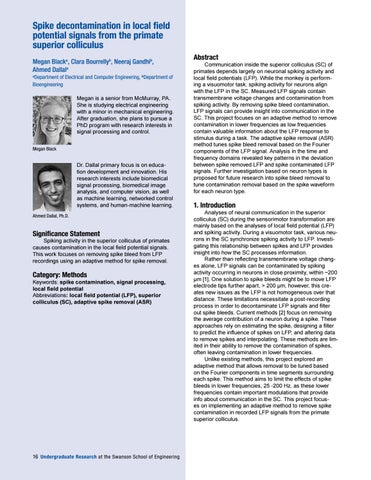Spike decontamination in local field potential signals from the primate superior colliculus Megan Blacka, Clara Bourrellyb, Neeraj Gandhib, Ahmed Dallala Department of Electrical and Computer Engineering, bDepartment of Bioengineering a
Megan is a senior from McMurray, PA. She is studying electrical engineering with a minor in mechanical engineering. After graduation, she plans to pursue a PhD program with research interests in signal processing and control. Megan Black
Dr. Dallal primary focus is on education development and innovation. His research interests include biomedical signal processing, biomedical image analysis, and computer vision, as well as machine learning, networked control systems, and human-machine learning. Ahmed Dallal, Ph.D.
Significance Statement
Spiking activity in the superior colliculus of primates causes contamination in the local field potential signals. This work focuses on removing spike bleed from LFP recordings using an adaptive method for spike removal.
Category: Methods
Keywords: spike contamination, signal processing, local field potential Abbreviations: local field potential (LFP), superior colliculus (SC), adaptive spike removal (ASR)
16 Undergraduate Research at the Swanson School of Engineering
Abstract
Communication inside the superior colliculus (SC) of primates depends largely on neuronal spiking activity and local field potentials (LFP). While the monkey is performing a visuomotor task, spiking activity for neurons align with the LFP in the SC. Measured LFP signals contain transmembrane voltage changes and contamination from spiking activity. By removing spike bleed contamination, LFP signals can provide insight into communication in the SC. This project focuses on an adaptive method to remove contamination in lower frequencies as low frequencies contain valuable information about the LFP response to stimulus during a task. The adaptive spike removal (ASR) method tunes spike bleed removal based on the Fourier components of the LFP signal. Analysis in the time and frequency domains revealed key patterns in the deviation between spike removed LFP and spike contaminated LFP signals. Further investigation based on neuron types is proposed for future research into spike bleed removal to tune contamination removal based on the spike waveform for each neuron type.
1. Introduction
Analyses of neural communication in the superior colliculus (SC) during the sensorimotor transformation are mainly based on the analyses of local field potential (LFP) and spiking activity. During a visuomotor task, various neurons in the SC synchronize spiking activity to LFP. Investigating this relationship between spikes and LFP provides insight into how the SC processes information. Rather than reflecting transmembrane voltage changes alone, LFP signals can be contaminated by spiking activity occurring in neurons in close proximity, within ~200 μm [1]. One solution to spike bleeds might be to move LFP electrode tips further apart, > 200 μm, however, this creates new issues as the LFP is not homogeneous over that distance. These limitations necessitate a post-recording process in order to decontaminate LFP signals and filter out spike bleeds. Current methods [2] focus on removing the average contribution of a neuron during a spike. These approaches rely on estimating the spike, designing a filter to predict the influence of spikes on LFP, and altering data to remove spikes and interpolating. These methods are limited in their ability to remove the contamination of spikes, often leaving contamination in lower frequencies. Unlike existing methods, this project explored an adaptive method that allows removal to be tuned based on the Fourier components in time segments surrounding each spike. This method aims to limit the effects of spike bleeds in lower frequencies, 25 -200 Hz, as these lower frequencies contain important modulations that provide info about communication in the SC. This project focuses on implementing an adaptive method to remove spike contamination in recorded LFP signals from the primate superior colliculus.
